The South of England contains some of the country’s most famous castles and fortresses with Windsor Castle, Dover Castle, Kenilworth Castle, and Warwick Castle all located here and many lesser-known castles, fortresses, and country houses besides!
From the Norman Conquest through to the much loved Tudor and Elizabethan eras, the South is the beating heart for those history fans who want to walk in the footsteps of England‘s most famous Royals including Henry VIII, Ann Boleyn, Elizabeth I and many others right up to the present day with the retreats of Queen Elizabeth, the Queen Mother and her Majesty Queen Elizabeth II also open to the public.
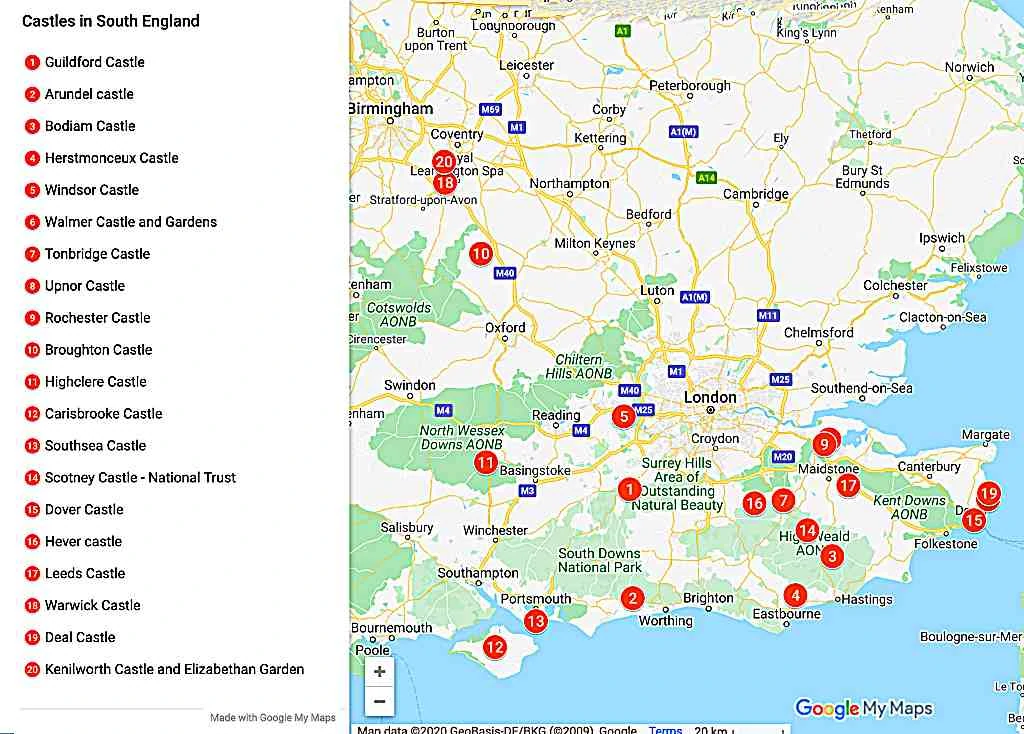
20 Castles Worth Visiting In Southern England
1. Guildford Castle
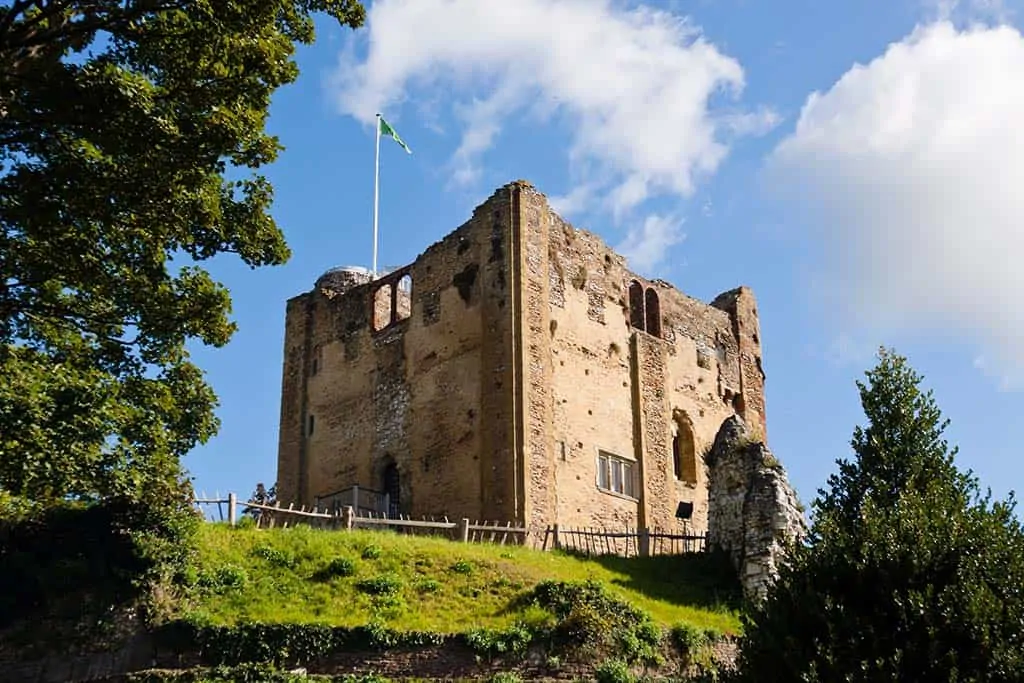
This castle started out as an earth and timber motte and bailey castle built soon after the Norman Conquest of 1066. Rebuilt from stone in the 1130s at which point a Great Keep was added, the castle underwent further improvements and expansion in the 13th century under orders from Henry II. The Keep was used as a jail and is the only part of the castle which can still be seen and climbed, today.
Where: Guildford, Surrey
When: 12th century
Style: Medieval
Open for visit: Yes, check here for more information.
2. Arundel castle
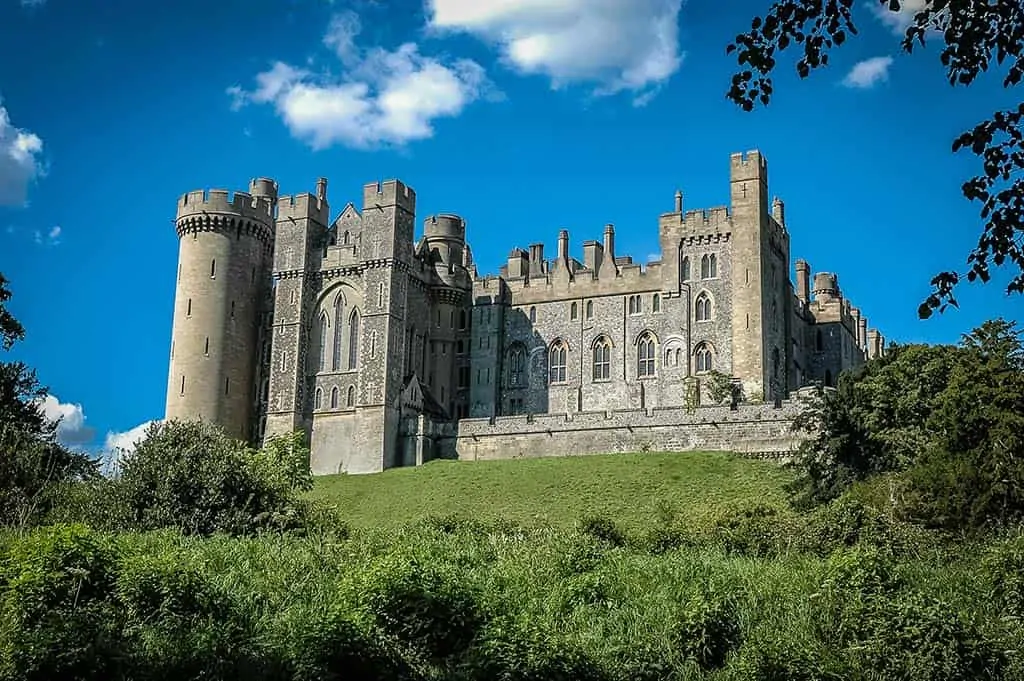
Founded on 25th December 1067 by the Earl of Arundel, Roger de Montgomery, Arundel Castle is both a restored Medieval castle and Gothic stately home.
One of the longest inhabited country houses in the whole of England, Arundel Castle has been the home of the Dukes of Norfolk for almost 1,000 years and retains many original Norman features including the Norman Keep, Medieval gatehouse, and Barbican.
Where: Arundel, Sussex
When: 11th century
Style: Medieval
Open for visit: Yes. Check here for more information.
3. Bodiam Castle
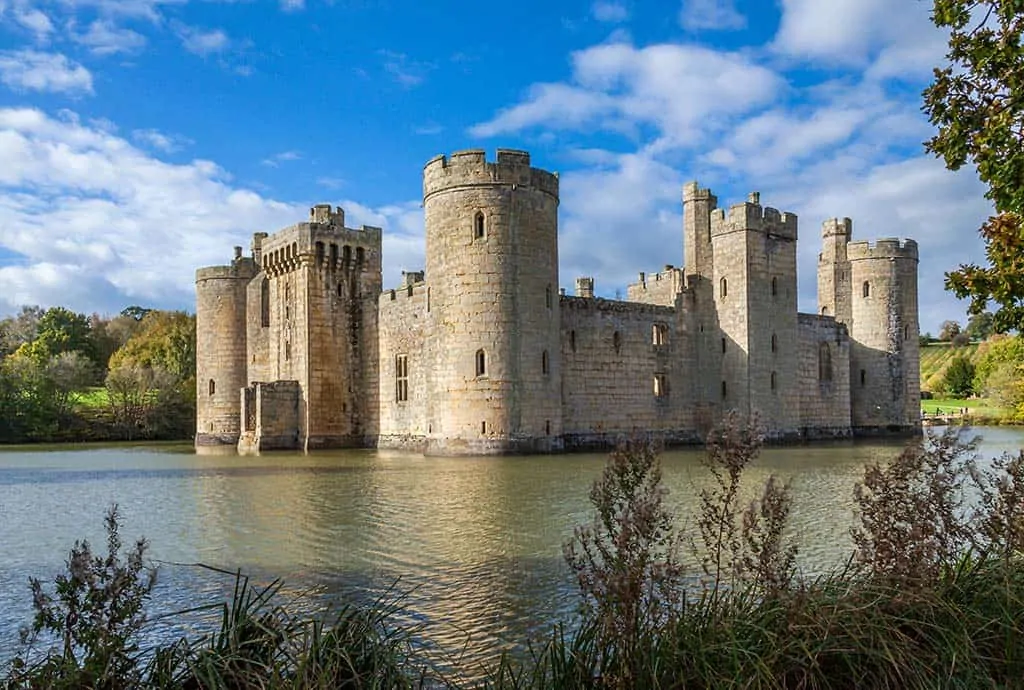
This medieval moated castle was founded on an older Saxon site in 1385 by a knight of Edward III, Sir Edward Dalyngrigge to defend the East Susses area against the French during the Hundred Years’ War.
Standing in ruin today, Bodiam Castle makes a romantic first impression as visitors cross the moat using a wooden bridge before walking around the ruined barbican, gatehouse, chapel and courtyard learning the history of this castle.
Where: East Sussex
When: 14th century
Style: Medieval
Open for visit: Yes, check here for more information.
4. Herstmonceux Castle

This beautiful brick-built moated castle with 550 acres of woodland plus themed and formal Elizabethan gardens and Georgian style folly is one of the oldest brick buildings of significant size in the country.
Built as a Tudor-style country home in 1441 when owner Ralph Fiennes updated his existing manor house, Herstmonceux Castle became the largest private residence in England at the time showing off Ralph’s wealth and status.
Renovated in the 17th century and again in the 20th century after the house well into disrepair, today the castle is home of the Study Centre of Queen’s University Canada.
Where: Herstmonceux, East Sussex
When: 15th century
Style: Tudor
Open for visit: Guided tours subject to availability outside of term time, see website for details.
5. Windsor Castle

A Royal Residence for 39 of England’s Kings and Queens including Queen Victoria, Elizabeth I, and Henry VIII, Windsor Castle was built by William the Conqueror in 1070 as an earth and timber motte and bailey castle on a former Saxon Royal hunting ground.
The oldest and largest occupied castle in England, Windsor Castle became a Royal Palace made from stone in the 12th century and has kept its original footprint of double bailey with motte in between, the Round Tower seen today originally being the Norman Keep.
When Queen Elizabeth is not in residence, visitors can tour the state apartments taking in many of the castles Royal treasures.
Where: Berkshire
When: 11th century
Style: Norman
Open for visit: Usually open daily from 10 am but closures can happen at short notice when the Queen is in residence– Check the website for full details.
6. Walmer Castle and Gardens

Originally an artillery fort built in 1539 for Henry VIII as part of the King’s Device programme which protected England against invasion from France and the Holy Roman Empire whilst also protecting the Downs anchorage off the English coast, Walmer Castle later became a stately home of the Lords Warden of the cinque ports.
Most recently Walmer Castle was home to Queen Elizabeth the Queen Mother but prior to that it was the home of the Duke of Wellington, the exhibits inside the castle today helping visitors to understand Wellington’s life story whilst outside in the beautiful grounds, visitors can see what the Queen Mother so enjoyed.
Where: Walmer, Kent
When: 16th century
Style: Tudor
Open for visit: Yes, check here for more information.
You might also be interested in: The best castles in Kent.
7. Tonbridge Castle
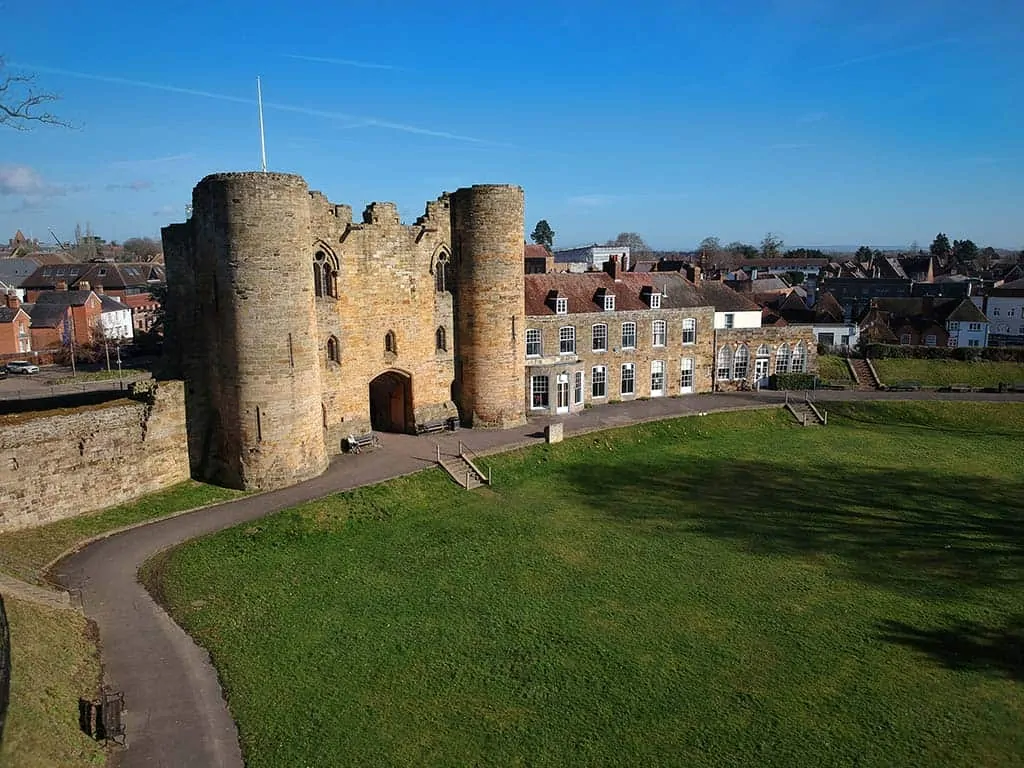
Built by William the Conqueror as an earth and timber motte and bailey castle in the 11th century, Tonbridge Castle was rebuilt from stone in the 13th century at which point a gatehouse was added.
Damaged in the Civil War, the castle was demolished in the 18th century with only partial pieces of the Southern walls visible by the river today. The castle that joins the gatehouse today dates from 1793, the exhibitions taking you on a journey from the armoury to the top of the tower as you learn how the Kings, Archbishops, and tyrants have shaped 700 years of Tonbridge history.
Where: Tonbridge, Kent
When: 13th / 18th century
Style: Medieval
Open for visit: Yes. Click here for more information.
8. Upnor Castle
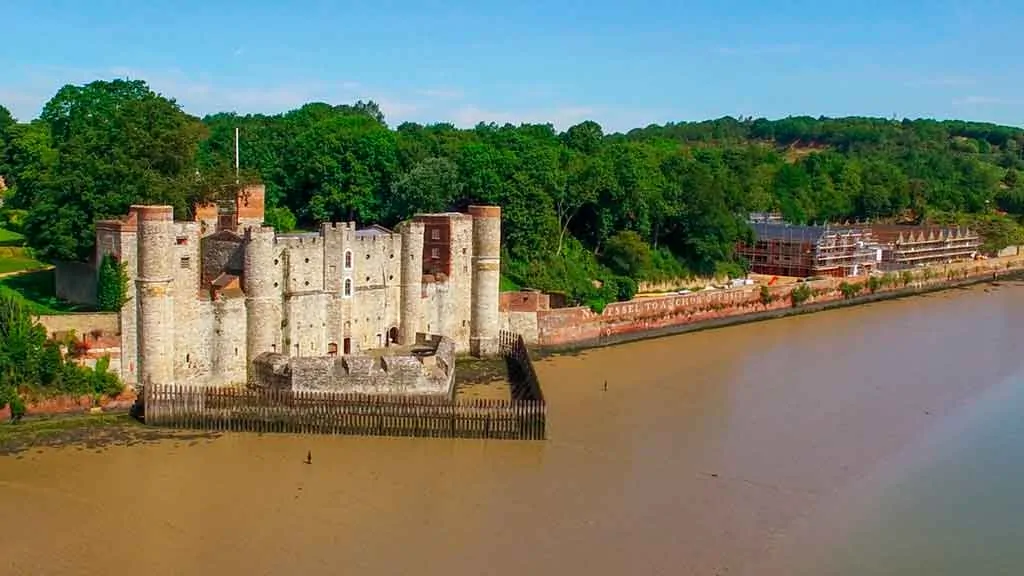
Built on the orders of Elizabeth I in 1559 as an artillery fortress to protect the warships at the key naval facility of Chatham dockyards, Upnor Castle, unfortunately, did not live up to its expectations with Dutch ships sailing straight past the castle in 1667 to burn and capture the anchored English fleet.
Today, visitors can see inside the rare example of an Elizabethan artillery fortress with an audio-visual tour that tells the story of the Dutch raid on the British fleet.
Where: Upper Upnor, Rochester, Kent
When: 16th century
Style: Elizabethan
Open for visit: Yes. Check here for more information.
9. Rochester Castle

Built from timber on a fortified Roman town soon after the Norman Conquest, Rochester Castle soon grew to become a substantial stone fortress, the Norman Keep that still stands is one of the best-preserved in England.
Caught up in battle during the Barons’ War of 1264, the castle underwent extensive damage but repairs were not made for 100 years, Edward III eventually rebuilding the walls and Richard II later building the Northern bastion, Rochester Castle remaining a viable fortress until the 16th century.
Where: Kent
When: 12th century
Style: Norman
Open for visit: Yes, check here for more information.
10. Broughton Castle
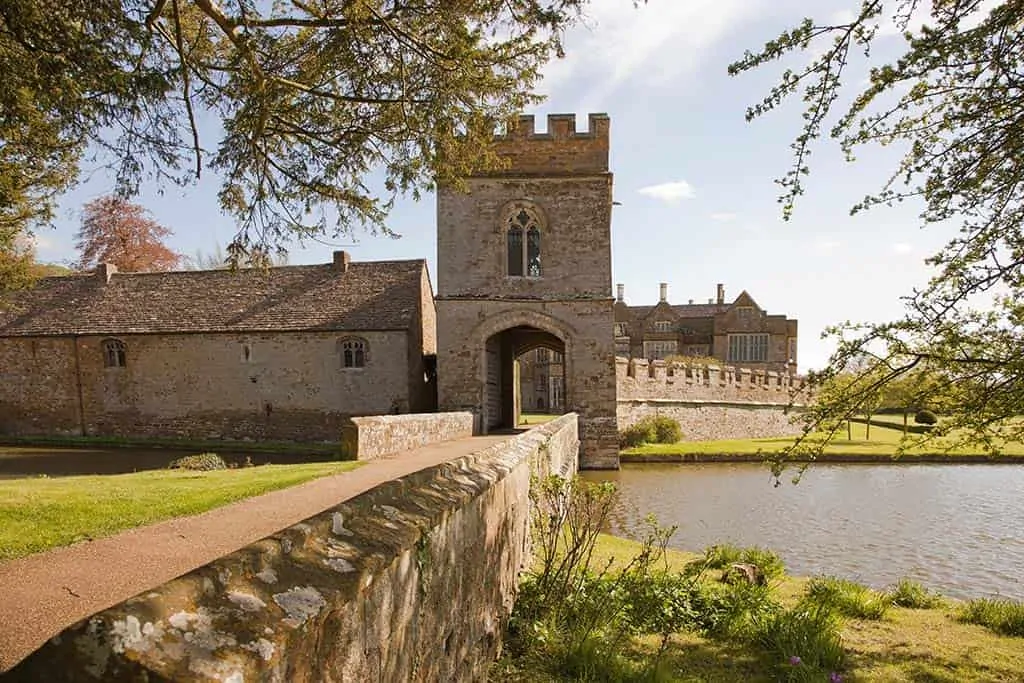
This idyllic castle is not a true castle made for battles but instead a fortified manor house.
Built on an artificial island and protected by a wide moat, Broughton Castle with its beautiful gardens was built by Sir John de Broughton in 1300.
The home of the Barons Saye and Sele since 1447, and still the home of their ancestors, most of the architecture seen today dates from the 1550s.
Where: Banbury, Oxfordshire
When: 14th / 16th century
Style: Medieval
Open for visit: Yes, check here for more information.
11. Highclere Castle
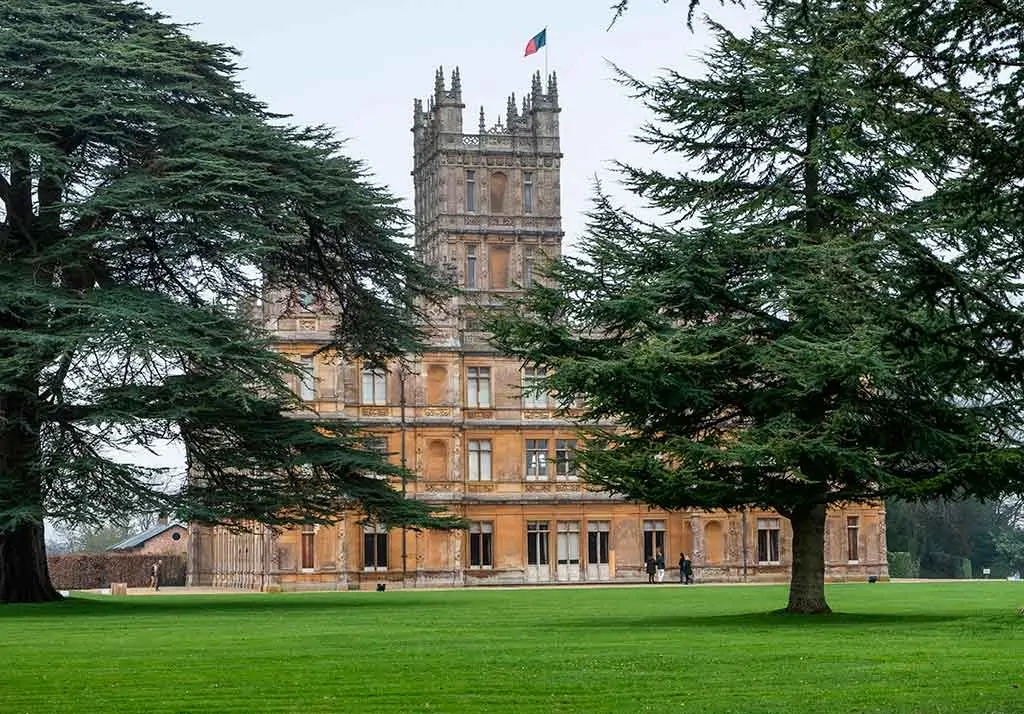
With a history dating as far back as 749, this 5.000-acre estate with a park designed by Capability Brown and beautiful Jacobethan country house built by Charles Barry has become a favourite of the nation owing to it featuring in the TV series Downton Abbey.
Visitors to Highclere castle can choose a Downton themed tour in which they can see the staterooms shown in the TV series or take a history tour that tells the story of the real family who has lived here over the centuries.
Where: Hampshire
When: 19th century
Style: Jacobethan
Open for visit: Tours available on selected dates – See the website for details.
12. Carisbrooke Castle
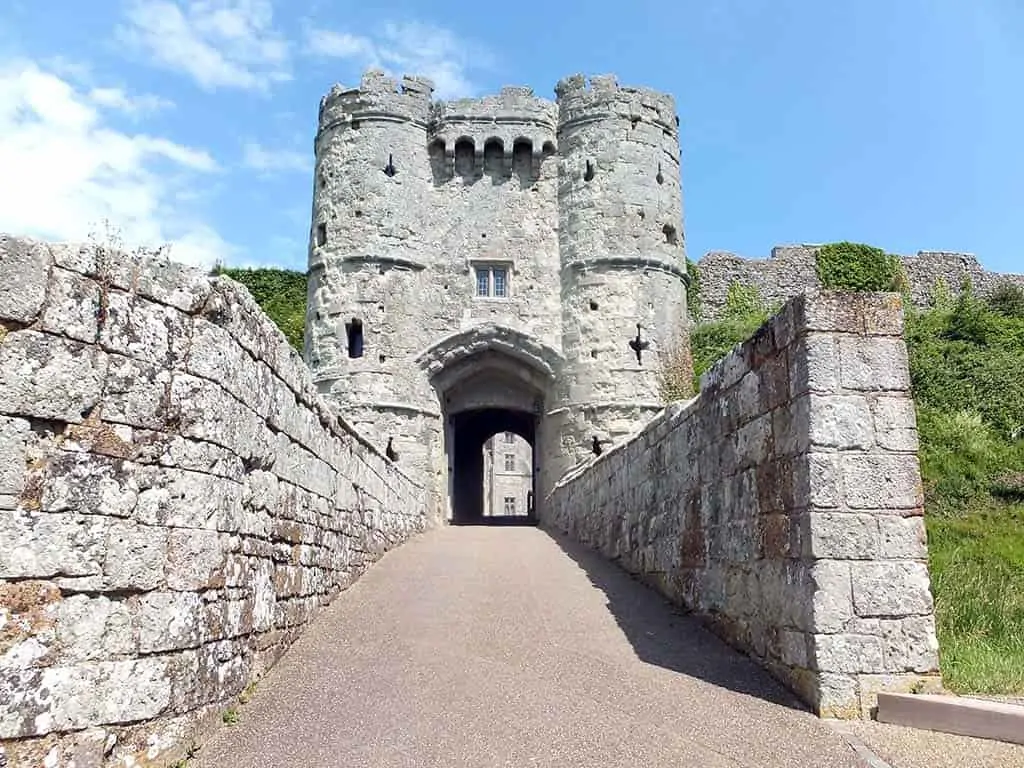
The chief place of power and protection on the Isle of Wight for more than 1,000 years, Carisbrooke Castle started out as a Saxon fortress before rebuilt as a Norman motte and bailey castle, eventually becoming an Elizabethan artillery fortress and, later, a Royal Summer residence.
With its many uses over the centuries, the castle is rich in history, besieged by the French in the 100 Year’s War and later, the place where Charles I was held prisoner, visitors can learn all that happened at Carisbrooke Castle and the history of the Isle of Wight thanks to the onsite information.
Where: Newport, Isle of Wight
When: 12th century
Style: Norman & Edwardian
Open for visit: Yes – Check the English Heritage site for details.
13. Southsea Castle
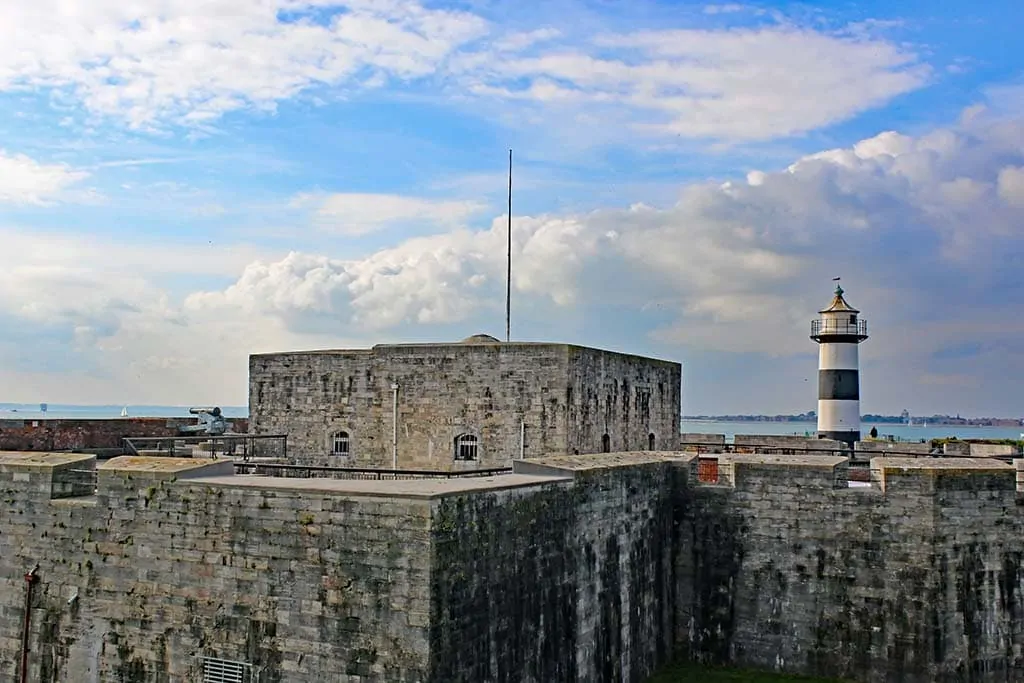
Known as Chaderton Castle and Portsea Castle in the past, Southsea castle, as it’s known today, started out as an artillery fort built for Henry VIII in 1544.
Unique in its design, this being one of the last defence forts that Henry VIII commissioned to protect the English coast, it was from Southsea Castle that Henry VIII saw his beloved Mary Rose ship capsize due to French attack.
In the 18th-century the castle was destroyed by a gunpowder explosion, hasty repairs carried out over the years with a final overhaul taking place in the early 19th century which saw the Tudor watchtower replaced with a curved bastion for a seaward facing battery and ultimately, the fortress converted to a military prison.
Where: Southsea, Portsmouth
When: 16th / 19th century
Style: Italienne
Open for visit: Yes, check here for more information.
14. Scotney Castle

This English country house with moat and formal gardens is truly a picturesque place. Originally a manorial site that was converted into a small fortification in the 14th century, the property was greatly modified and expanded by Edward Hussey III in the Elizabethan era using sandstone from the original castle.
It was at this time that a priest hole was added by the Catholic owners to hide Father Richard Blount from Elizabeth I Protestant commissioners.
Today, visitors can admire the view from the gardens that are filled with rhododendrons and azaleas in the Spring-Summer months before stepping inside to see how the last owner left the interior.
Where: Lamberhurst, Tunbridge Wells, Kent
When: 14th century
Style: Tudor Revival
Open for visit: Yes, check here for more information.
15. Dover Castle
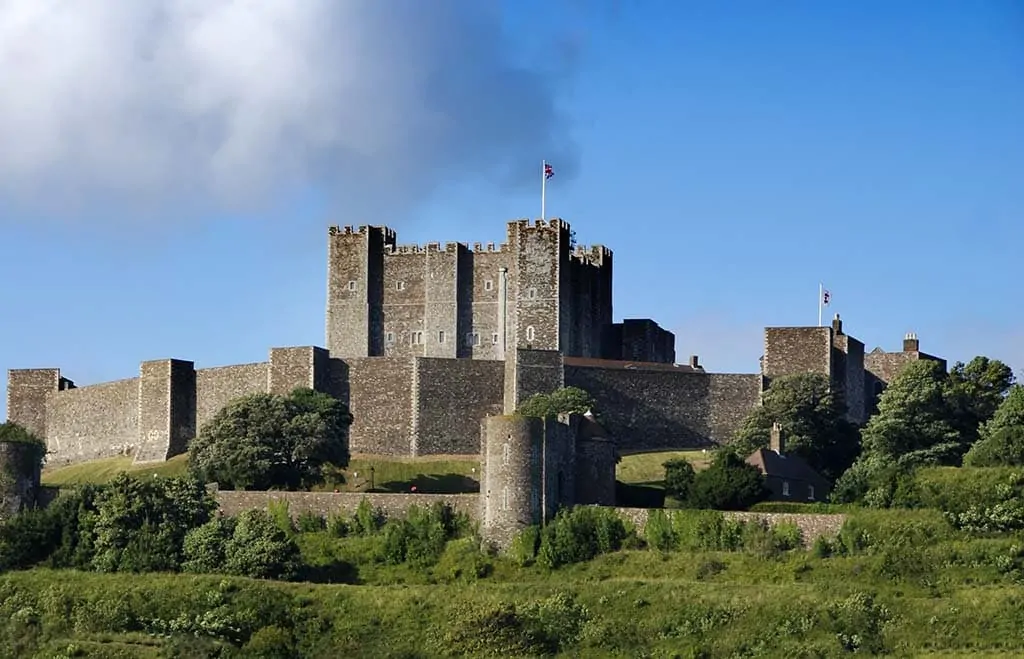
The most iconic Medieval fortress in England that became known as ‘the key to England’ due to its location on the White Cliffs, Dover Castle has 9 centuries of history waiting to be explored.
Built as a motte and bailey castle by the Normans close to Roman and Saxon activity, visitors can see the best-preserved Roman lighthouse, see inside the Norman Keep built by Henry II, and learn how this castle has played a vital defence role in history right through to the second world war when Operation Dynamo was created in its secret underground tunnels.
Where: Kent
When: 11th century
Style: Medieval
Open for visit: Yes. – Check the English Heritage website for details.
16. Hever castle
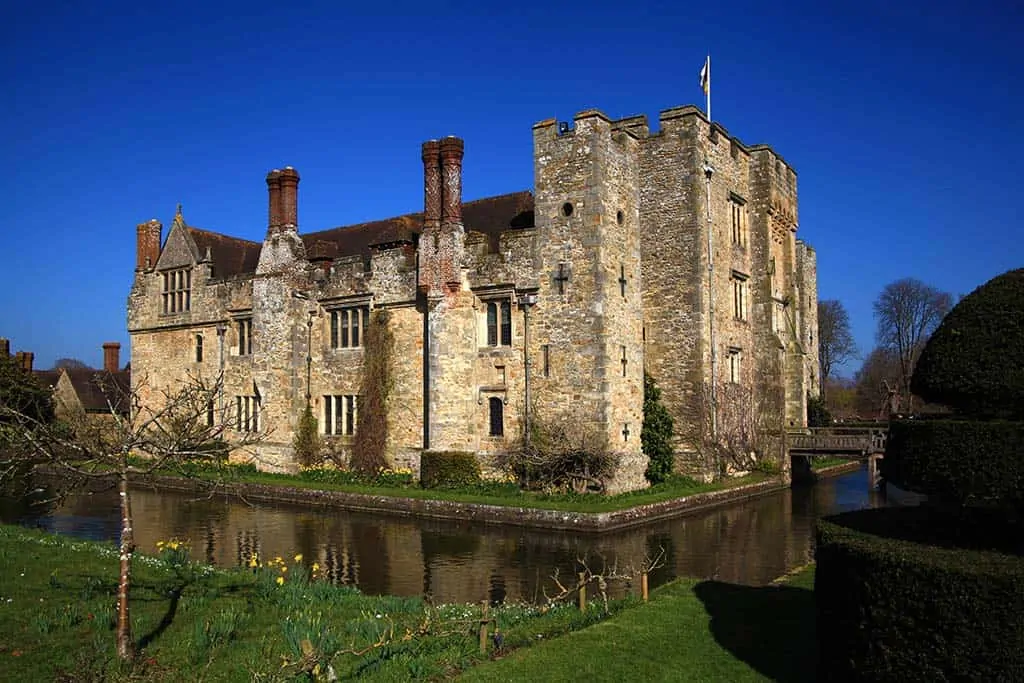
The childhood home of Anne Boleyn, remaining in the Boleyn family from 1462-1539, this double moated castle, you could say, shaped the history of England.
Built in 1270 as a defensive castle with gatehouse and bailey, it sits in 125 acres of gardens and grounds with a fun maze to find your way around.
The interior of the house contains countless Tudor relics including furniture, tapestries and paintings, antiques, and book including 2 prayer books owned by Anne.
Where: Hever, Edenbridge, Kent
When: 13th century
Style: Medieval
Open for visit: Yes. – See website for details.
17. Leeds Castle
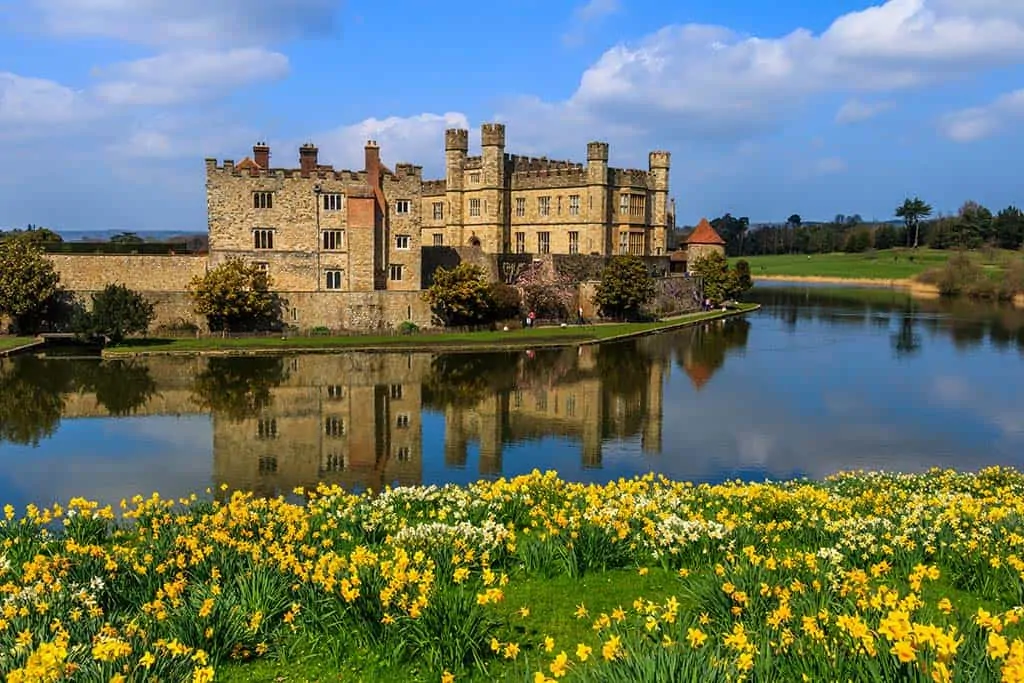
This 900-year old castle is situated on islands formed by the River Len just outside of the village of Leeds near Maidstone, Kent.
Originally a Norman castle built in 1119, it went on to become a Royal palace for 6 of England’s Kings and Queens including King Henry VIII and his first wife Catherine of Aragon.
Today visitors can see the staterooms, visit the gatehouse exhibition and visit the unusual dog collar museum which is also on-site!
Where: Maidstone, Kent
When: 12th century
Style: Norman
Open for visit: Yes. Check here for more information.
18. Warwick Castle
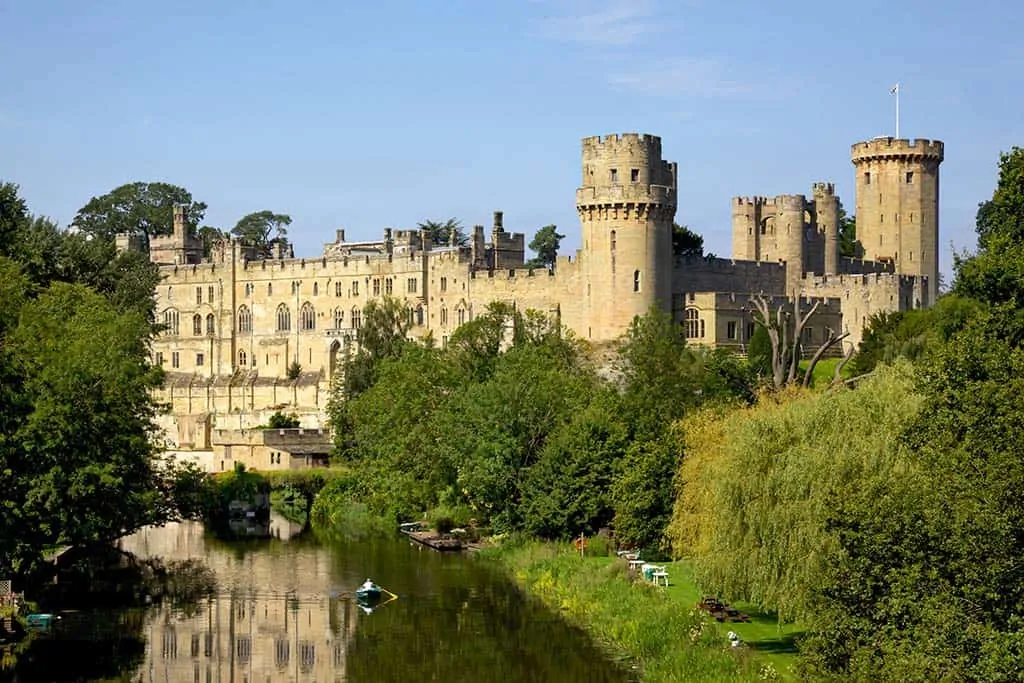
Firstly a Roman fort and then an Anglo Saxon burg, William the Conqueror built a motte and bailey castle here in 1086, initially using earth and timber before rebuilding the castle from stone.
With a history spanning 1,000 years, and the towers, ramparts, and dungeons open to visitors, there’s plenty of history to get your teeth into here, Warwick Castle has played a central role in the overthrow of Edward II and the Wars of the Roses.
Where: Warwickshire
When: 12th century
Style: Medieval
Open for visit: Yes. Check here for more information.
19. Deal Castle
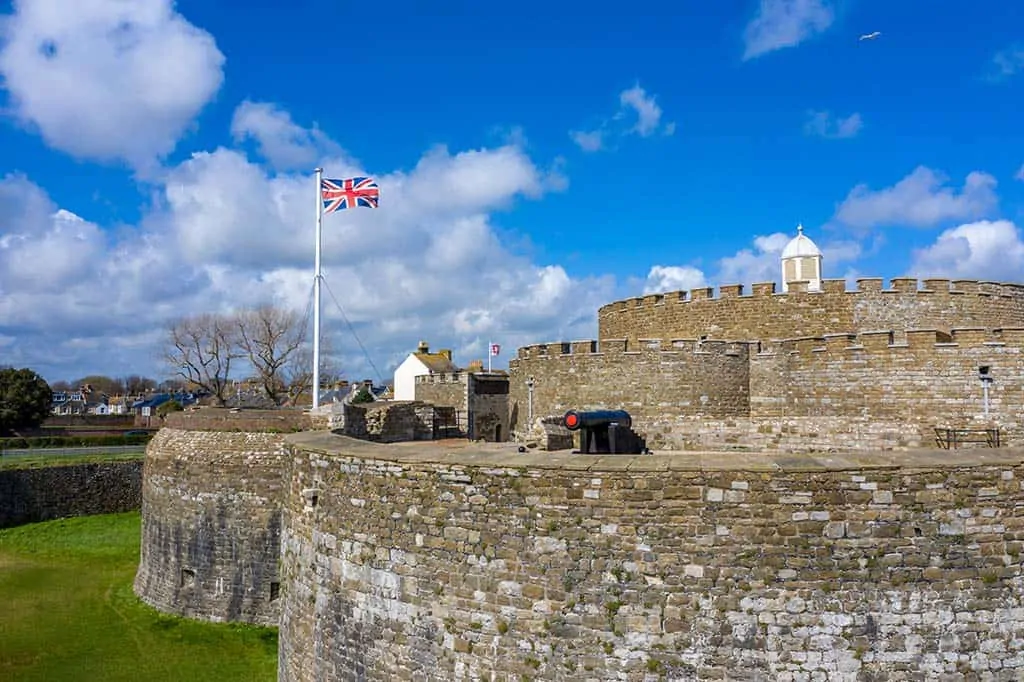
The earliest, largest, and most elaborate of Henry VIII’s 3 coastal artillery forts, Deal Castle was built in 1539 forming part of the King’s Device programme which protected the Downs.
It remained in use as a defence fortress right through the reign of Elizabeth I until the Napoleonic Wars, the fort so strong that it withstood a 3-month siege when it was garrisoned by the Royalists during the Second Civil War.
Today, visitors to Deal Castle can learn about Henry VIII’s obsession with safety and security at the permanent exhibition, the architecture dating mostly from the 18th century.
Where: Deal, Kent
When: 16th / 18th century
Style: Medieval Revival
Open for visit: Yes, check here for more information.
20. Kenilworth Castle and Elizabethan Garden
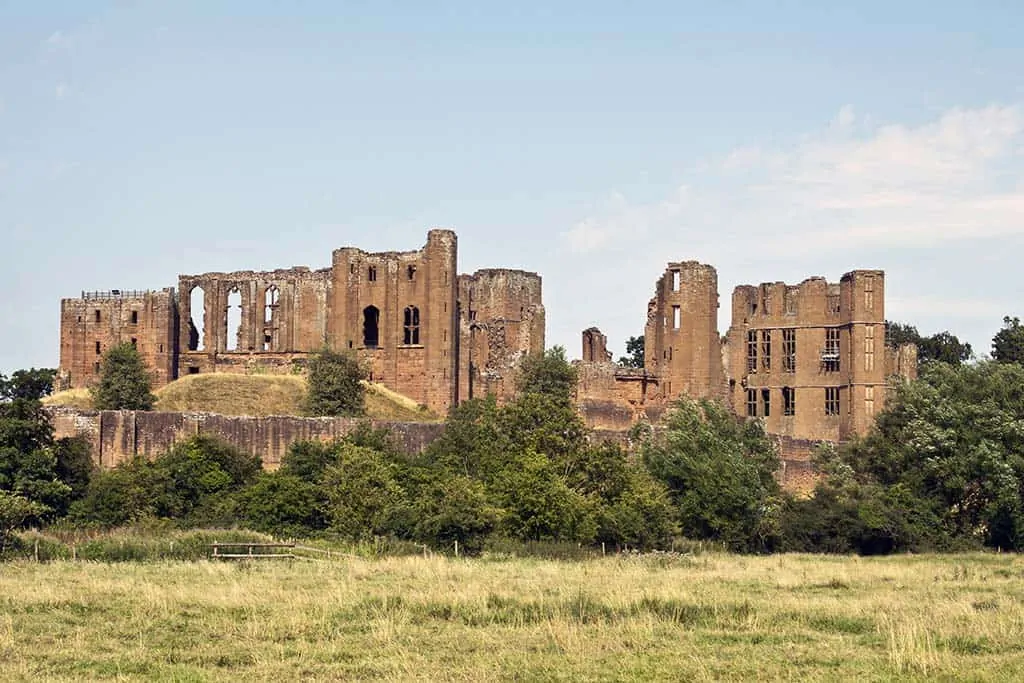
This 900-year old Medieval fortress was originally built by the Normans, some 50 years after the Norman Conquest, but is most well known for its Tudor history, becoming the home of Robert Dudley, Earl of Leicester and suitor to Queen Elizabeth I.
The largest castle ruin in England, visitors can see the Norman Keep, the Tudor Gatehouse, and walk around the stunning recreation of the Elizabethan gardens as they trace the history of this castle and its people back through the ages.
Where: Warwickshire
When: 13th century
Style: Norman
Open for visit: Yes. Check here for more information.
